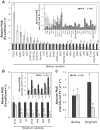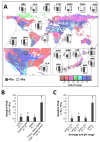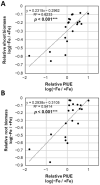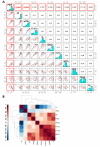Enhancement of Photosynthetic Iron-Use Efficiency Is an Important Trait of Hordeum vulgare for Adaptation of Photosystems to Iron Deficiency
- PMID: 33504088
- PMCID: PMC7911540
- DOI: 10.3390/plants10020234
Enhancement of Photosynthetic Iron-Use Efficiency Is an Important Trait of Hordeum vulgare for Adaptation of Photosystems to Iron Deficiency
Abstract
Leaf iron (Fe) contents in Fe-deficiency-tolerant plants are not necessarily higher than that in Fe-deficiency-susceptible ones, suggesting an unknown mechanism involved in saving and allowing the efficient use of minimal Fe. To quantitatively evaluate the difference in Fe economy for photosynthesis, we compared the ratio of CO2 assimilation rate to Fe content in newly developed leaves as a novel index of photosynthetic iron-use efficiency (PIUE) among 23 different barley (Hordeum vulgare L.) varieties. Notably, varieties originating from areas with alkaline soil increased PIUE in response to Fe-deficiency, suggesting that PIUE enhancement is a crucial and genetically inherent trait for acclimation to Fe-deficient environments. Multivariate analyses revealed that the ability to increase PIUE was correlated with photochemical quenching (qP), which is a coefficient of light energy used in photosynthesis. Nevertheless, the maximal quantum yield of photosystem II (PSII) photochemistry, non-photochemical quenching, and quantum yield of carbon assimilation showed a relatively low correlation with PIUE. This result suggests that the ability of Fe-deficiency-tolerant varieties of barley to increase PIUE is related to optimizing the electron flow downstream of PSII, including cytochrome b6f and photosystem I.
Keywords: Fe economy; barley; electron transport chain; iron deficiency; photosynthetic iron (Fe)-use efficiency; photosystem I; photosystem II; sorghum.
Conflict of interest statement
The funder EARTHNOTE Co., Ltd. had no role in the design of the study; in the collection, analyses, or interpretation of data; in the writing of the manuscript, or in the decision to publish the results. All authors declare no competing interests.
Figures










References
-
- Michel K.P., Pistorius E.K. Adaptation of the Photosynthetic Electron Transport Chain in Cyanobacteria to Iron Deficiency: The Function of IdiA and IsiA. Physiologia Plantarum. Volume 120. Wiley; Hoboken, NJ, USA: 2004. pp. 36–50. - PubMed
Grants and funding
LinkOut - more resources
Full Text Sources
Other Literature Sources
Research Materials

